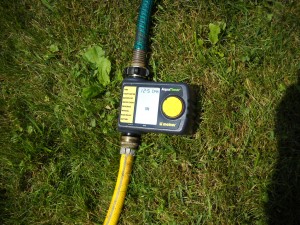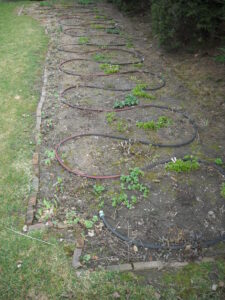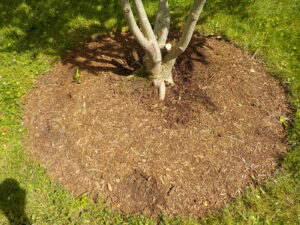Are Your Plants Suffering from a Drought?
Many of my readers are suffering from a serious drought, enough so that plants are losing leaves and going dormant long before they should. Most well established plants will recover from the effects of drought, even if they lose their leaves now. And new things? If you have not been giving them water weekly or more often, some may die.
If you are using a hose, use a watering wand to apply water rather than a spray nozzle held in your hand. These wands are usually 24 inches long with a nice “rose” on the end that makes the water flow in a gentle spray and have a valve to turn the water on, off, or part way on. Since the tip of the wand is near the ground, it is less likely to wash away the soil. And it allows you to direct the water just where you want it. Soaker hoses on timers are good if you travel a lot, or vacation when it’s hot and dry.
Grasses and weeds suck moisture out of the soil, so dig them out around your trees. Weed a ring around new or struggling trees that is 3 to 4-feet wide. Then get some fine mulch (double-ground mulch, not wood chips). An inch and a half of mulch is about right, or two inches. Deeper than that and short rain showers will never get moisture to your plants’ roots.
What to do in Hot, Dry Weather
We New Englanders are pretty lucky. Much of the country is saddled with a hot dry spell reminiscent of the dust bowl era of the 1930’s. I’ve seen pictures in the paper of wizened corn and unhappy farmers scratching their heads and looking up at a cloudless, unforgiving sky. We’ve had more than our fair share of hot days – in the high nineties, even – but so far I’ve had at least a thunderstorm once a week. Each week vegetables (and many flowers) need one inch of water –either from the sky, or from your watering can – but we don’t always get that.
Recently I went to water the garden of a friend who was away for a week. The soil was as dry as powder. She had planted pole beans before she left, and they should have sprouted, but had not. I watered the bean plot, but water from the hose wouldn’t penetrate the soil. It just ran off. So I scratched the surface to loosen up the crust on top, and re-watered a few times using a watering can, giving it a slow sprinkle. Finally it worked: when I poked a finger into the soil it was dark and moist for at least 2 inches. Then I spread a light layer of straw over the soil to shade it.
Imagine yourself marooned on a desert island. No shade? You bake. Add a palm tree or two, and you survive nicely. Same for your lettuce and tomatoes. The plants love the sun, but their roots need some shade in hot, dry times.
In the vegetable garden I favor a layer of newspapers – 4 to 6 sheets thick – covered with straw, hay or leaves. I keep the newspapers away a little from the stem of each plant, as I want moisture from light rains to reach the soil. Straw comes from grain crops that have been threshed, so it is not supposed to have seeds (though it always has a few). Mulch hay always has seeds; it is grass grown for fodder for cows and sometimes it gets spoiled as feed (by rain) and sold cheaply to gardeners. The price difference is considerable – $3 for hay versus $10 or more for straw, so I generally use hay. The newspapers help to keep seeds out of the soil.
What kind of watering device is best? I’ve tried plenty of them, most recently soaker hoses. Soaker hoses are designed to leak. They are a rubber-like substance that is somewhat porous. They ooze water their entire length, and that water spreads out for about 6 inches around each hose. I installed a pressure regulator and a filter to keep particles from the water source (a pond) from clogging the pores of the soaker hose. Still, some rows – or sections of a row- got more water than others – and not in a predictable way. So some plants got little or no water, some got too much; a few rows had perfectly even distribution.
I also installed a timer, which allowed my client to go away and know her beets or tomatoes were being watered in her absence. Timers work, but get the simplest kind possible. I have installed some that you have to program, and find those can be aggravating. I like a simple one that comes on every day at the same time, but allows you to set how long the hose will run. Test it well – before you go on vacation.
While working as a WWOOFer on a willow farm in France a few years ago I set up an emitter watering system; it worked a lot better than the soaker hoses. (WWOOF stands for Willing Workers on Organic Farms; see www.WWOOF.org for details). The system ran three quarter-inch plastic feeder lines down the rows of plants. I used a special tool to punch holes in the feeder line and inserted barbed connectors that attached to quarter-inch lines. Each small line went to an emitter that delivered a measured amount of water per hour, depending on plant needs. Some emitters just oozed water, other types sent out a spray to cover 2 square feet or so.
 One nice thing about an emitter system is that you don’t end up watering the weeds: if you put an emitter at each tomato plant, for example, the space between plants is not watered the way it is with a soaker hose. And you can see (and replace) an emitter that gets clogged and does not deliver water. I can’t figure out why most garden centers on the East coast don’t sell these systems –every hardware store in California does.
One nice thing about an emitter system is that you don’t end up watering the weeds: if you put an emitter at each tomato plant, for example, the space between plants is not watered the way it is with a soaker hose. And you can see (and replace) an emitter that gets clogged and does not deliver water. I can’t figure out why most garden centers on the East coast don’t sell these systems –every hardware store in California does.
Lawns in August can look pretty brown if a watering ban is put in place – especially if you only use chemicals on your lawn. Lawns that are given compost every year and have biologically active soil seem to do much better at staying green in dry times. It also helps to keep the grass longer in August – taller grass helps to shade the soil, like those palm trees mentioned above.
We’re all largely dependent on the heavens to provide our lawns and gardens with rain. But if we treat our soil well and provide plenty of organic matter, everything does better in times of stress – including the gardener.
Henry Homeyer is a garden designer and the author of 4 gardening books. His Web site is www.Gardening-guy.com.






